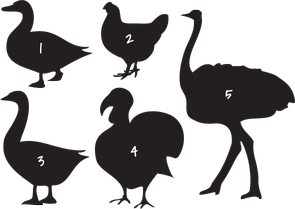
Poultry
Poultry - not just chicken
- Demand on better quality raw material.
- Be careful what you buy, quality pays off in taste.
- The more color, the better taste.
- Separate for good hygiene.
- Other poultry is also delicious.
There are literally hundreds of different breeds of poultry around the world. For thousands of years, chickens have been domesticated for a variety of reasons, whether for their eggs, meat or feather – some even for fighting! But many other birds are harvested for their eggs, meat and other produce, including duck, goose, turkey, ostrich, rhea, Indian peafowl, pigeon, pheasant and guinea fowl.
A little background
For most people, an ordinary, cheap grilled chicken is their main encounter with poultry, especially battery chickens bred indoors on a minimal surface and as quickly possible.
For a chicken to receive the epithet ”ecological”, natural feed is mandatory as well as being bred in a free-range environment.
A cockerel gets a little longer time to grow up. It has more time to develop greater taste and character, which is noticeable at the first bite.
A spring chicken is born during this season and is younger and smaller when slaughtered.
Poultry's inner temperature
Poultry should reach a recommended temperature of 72°C, but at this temperature breast and other lean parts are already dry. You will achieve a juicier result if you stop the preparation somewhat earlier and let the meat finish cooking through the after heat.
Corn is just feed
The label “corn-fed chicken” is no guarantee that the chicken has been reared in humane conditions, in reality it just implies the bird has been fed a lot of corn in its diet. Check labeling to make sure any bird has been raised ‘free range’, meaning it has space to roam, outdoors or even inside.
The advantage with corn is that it creates nice tasting, juicy meat. The fat of corn-fed chickens is yellowish in color – and chickens that are yellow in color taste better than a paler, cheaper bird.
In the USA, corn is also used to feed cattle to produce nice, tasty beef meat.
Strict breeding rules
In many countries, chickens are reared on an industrial scale in hermetically closed barns in accordance with strict breeding rules in order to minimize the risk of salmonella and campylobacter. The biggest risk for contamination is unfortunately in the outdoor soil, something a chicken loves to peck at.
Widespread public revulsion at so-called ‘battery farms’ for chickens has led to much stricter controls to ensure chickens get a fair life. However, those of us who love food need to be constantly vigilant because there is a lot of truth in the belief that ‘a happy chicken is a good tasting chicken’. As consumers we should demand better quality chicken, and thereby influence quality of life conditions for the birds.
As with all other meat, it is worthwhile to buy good quality when you buy chicken.
Eat a bit less, but better.
Vive la Bresse
For many, France epitomizes the culinary art. So maybe it’s not surprising that one of the best chicken breeds in the world hails from France. Bresse birds are prized for their depth of flavor, fine, tender flesh and flowing fat. Bresse chickens are raised to exacting standards, often on small family farms and with diet and slaughter times strictly controlled. A Canadian variety of Bresse called Blue Foot is highly prized in the USA.
Other tasty birds
Turkey is becoming increasingly popular all year around. The meat is tasty, but easily can dry out. A tip is to cook a large, juicy leg instead of an entire small turkey, or just buy a portion of the breast meat.
The nicest parts of a duck are the fatty, delicious fillets. Fry on low heat on the skin side until the fat melts. Goose tends to be seasonal in most countries where it is sold.
Ostrich resembles beef in appearance and taste, but it is extremely lean. Cooking time is short. Use a lot of fat when cooking.
Guinea fowl remains a rarity, but has a richer, more delicious taste than chicken.
Crispier skin
A tip when you are going to roast or grill a whole chicken, or any other kind of bird, is to remove any plastic package well in advance and let it rest uncovered in the refrigerator, preferably on an airy grid. Be careful not to let it contact other food. This way, the skin dries out and gets a finer surface when cooking. Real Beijing duck should air dry thoroughly to achieve the characteristic, tasty and crispy skin.
Keep apart for health reasons
Do not use the same tools or cutting boards for raw chicken as for other food. Be careful to chill, wash and separate the raw material from other foodstuff.
A little knowledge about slaughtering
A chicken is normally between 30 to 40 days old when slaughtered. A Bresse
chicken is up to half a year and a hen is generally older.
The meatiest parts of most poultry are the breast, thigh and drumstick
parts. The wings can also be eaten (in the US, the dish is called Buffalo wings).





















